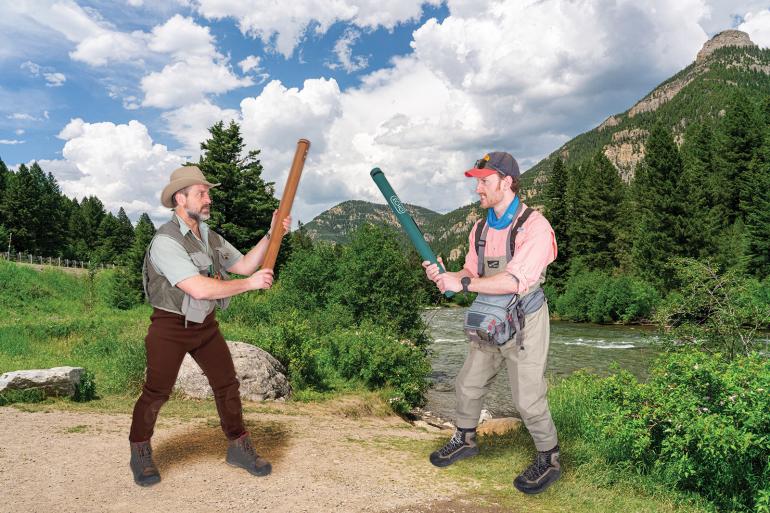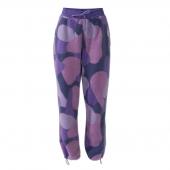Face-Off: Neoprene vs. Gore-Tex Waders
Sweating it out in waders.
Waders have come a long way since your grandfather’s first pair, which were likely made of vulcanized rubber with boots attached. Our forefathers stumped and crinkled in these ill-fitted, hazmat-like suits, yet probably caught more fish than us. Then, anglers started shimmying into neoprene waders. These became stock-standard for decades, until another material hit the market in the early ’90s: Gore-Tex. This groundbreaking fabric, and off-brand equivalents, like Patagonia’s H₂No, now inundate the wader section in most fly shops. But is it really that much better than neoprene? We’re putting these two to the test in a no-holds-barred face-off—may the best material win.
Comfort
Neoprene waders are often boot-foot, which is problematic as the foot-to-human size ratio has a wide range of possibilities. There are giants among us with tiny feet and wee people with big dogs. Stocking-foot Gore-Tex waders offer more comfort because you can size the boot separately. The thinner material, and overall more pant-like fit of Gore-Tex waders, also give them a leg up.
Edge: Gore-Tex
Durability
What Gore-Tex waders achieve in comfort, they sacrifice in durability. Brush a barbed-wire fence, scrape a piece of rebar, or bump into a metal bridge piling, and you’re likely to spring a leak. Not to mention endless pinholes that appear out of nowhere. Neoprene, on the contrary, is a thick material and difficult to tear. Punch a hole in these suckers and you’re probably headed for the hospital.
Edge: Neoprene
Breathability
Neoprene waders, with all their durability, are about as breathable as a garbage bag. They’re basically wetsuits. Unless you’re a wrestler attempting to shed weight, a mid-summer hike in neoprene waders is no fun at all. Gore-Tex, albeit thinner, allows both air and water vapor to pass through the wader while still blocking liquid water. This makes a five-mile hike on a 90-degree day a breeze, as sweat is wicked out of the wader. Pretty cool, eh?
Edge: Gore-Tex
Warmth
Fisherman could take a cue from duck hunters, who almost universally wear neoprene waders on their mid-winter exploits. When the temperature plummets, neoprene acts like a layer of blubber, keeping your body’s warmth close and the river’s cold out. Even if the boots are a little big, the extra room allows you to layer up with an extra pair of socks, or wiggle your toes in the trapped, warm air. Gore-Tex, on the other hand, requires multiple pairs of long johns, which even then sometimes isn’t enough.
Edge: Neoprene
Mobility
Neoprene waders can be a bit stiff and clunky, especially if it’s a cold day. Layer up under Gore-Tex, though, and you’re likely to feel like the Pillsbury Doughboy. In the summer, however, the flexibility and versatility of Gore-Tex waders shines, whether it be boulder-hopping on the banks, scrambling down a scree-field to the river, or picking through log jams. Gore-Tex easily champions the mobility test.
Edge: Gore-Tex
Attractiveness
It’s true: nobody looks good in waders. In fact, when Justin Timberlake and Jessica Biel, who have a house in Big Sky, want to conceal their beauteous identities and blend in with those of average unattractiveness, nothing does the job quite like a pair of waders. Which works better? Neoprene’s spongy thickness blurs all curves into a frumpy swath of neo-Amish fashion, while the loose folds of Gore-Tex over long underwear scream People of Walmart. Either way, you’re not turning heads today.
Edge: Tie
Affordability
A new, premium Gore-Tex wader can cost a good portion of a paycheck, and don’t forget that boots aren’t included in that package. And, depending on how often you use them, they might only last a few seasons. Neoprene, however, will keep you dry at a fraction of the cost, and it’ll serve you well for a decade or more. It might not be as comfortable, but your bank account will appreciate it.
Edge: Neoprene
Score: 3 to 3
Winner: Tie
It all boils down to what you need your waders to do. If you want something breathable and easy to move in, go with Gore-Tex. But if you’re fishing in really cold water where durability and warmth are almost as important as catching fish, neoprene waders fit the bill. And if you can’t make up your mind, just wait for a warm summer day when all you need on your feet is some traction and a little protection from sharp rocks—in which case, an old pair of tennies’ll do the trick.














